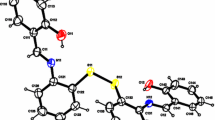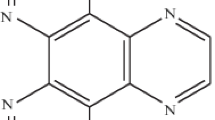Abstract
The rutin–nickel (II) complex (RN) was synthesized and characterized by elemental analysis, UV–visible spectroscopy, IR, mass spectrometry, 1H NMR, TG-DSC, SEM, and molar conductivity. The low molar conductivity value investigates the non-electrolyte nature of the complex. The elemental analysis and other physical and spectroscopic methods reveal the 1:2 stoichiometric ratio (metal/ligand) of the complex. An antioxidant study of rutin and its metal complex against DPPH radical showed that the complex has more radical scavenging activity than free rutin. The interaction of complex RN with DNA was determined using fluorescence spectra and agarose gel electrophoresis. The results showed that RN can intercalate moderately with DNA, quench a strong intercalator ethidium bromide (EB), and compete for the intercalative binding sites. The complex showed significant cleavage of pBR 322 DNA from supercoiled form (SC) to nicked circular form (NC), and these cleavage effects were dose-dependent. Moreover, the mechanism of DNA cleavage indicated that it was a hydrolytic cleavage pathway. These results revealed the potential nuclease activity of the complex to cleave DNA.











Similar content being viewed by others
References
Balasundram N, Sundram K, Samman S (2006) Phenolic compounds in plants and agri-industrial by-products: antioxidant activity, occurrence, and potential uses. Food Chem 99(1):191–203
Harborne JB, Williams CA (2000) Advances in flavonoid research since 1992. Phytochemistry 55(6):481–504
Dehghan G, Shafiee A, Ghahremani MH, Ardestani SK, Abdollahi M (2007) Antioxidant potential of various extracts from Ferula szovitsiana. In relation to their phenolic content. Pharm Biol 45(9):691–699
Bukhari SB, Memon S, Mahroof-Tahir M, Bhanger M (2009) Synthesis, characterization and antioxidant activity copper–quercetin complex. Spectrochim Acta A Mol Biomol Spectrosc 71(5):1901–1906
Kamalakkannan N, Prince PSM (2006) Antihyperglycaemic and antioxidant effect of rutin, a polyphenolic flavonoid, in streptozotocin-induced diabetic Wistar rats. Basic Clin Pharmacol Toxicol 98(1):97–103
Deschner EE, Ruperto J, Wong G, Newmark HL (1991) Quercetin and rutin as inhibitors of azoxymethanol-induced colonic neoplasia. Carcinogenesis 12(7):1193–1196
LIN J, LUO L, CHEN L, YU J (2012) Synthesis, characterization and antibacterial activity of rare earth lanthanum-rutin complex [J]. J Text Res 5:017
Aleksandrov P, Speranskaia T, Bobkov I, Zagorevskiĭ V, Zykov D (1985) Effect of rutin and esculamine on models of aseptic inflammation. Farmakologiia i toksikologiia 49(1):84–86
Carlo G, Izzo A, Maiolino P, Mascolo N, Viola P, Diurno M, Capasso F (1993) Inhibition of intestinal motility and secretion by flavonoids in mice and rats: structure-activity relationships. J Pharm Pharmacol 45(12):1054–1059
Pozin V, Skuratovskaia S, Pocheptsova G (1995) Changes in the vascular wall and ischemic damages to the myocardium in reversible episodes of heart muscle ischemia. Fiziolohichnyi zhurnal (Kiev, Ukraine: 1994) 42(1–2):10–16
Santos B, Silva A, Pitanga B, Sousa C, Grangeiro M, Fragomeni B, Coelho P, Oliveira M, Menezes-Filho N, Costa M (2011) Antiproliferative, proapoptotic and morphogenic effects of the flavonoid rutin on human glioblastoma cells. Food Chem 127(2):404–411
Gryglewski RJ, Korbut R, Robak J, Świȩs J (1987) On the mechanism of antithrombotic action of flavonoids. Biochem Pharmacol 36(3):317–322
Lapidot T, Walker MD, Kanner J (2002) Antioxidant and prooxidant effects of phenolics on pancreatic β-cells in vitro. J Agric Food Chem 50(25):7220–7225
Afanas’ ev IB, Dcrozhko AI, Brodskii AV, Kostyuk VA, Potapovitch AI (1989) Chelating and free radical scavenging mechanisms of inhibitory action of rutin and quercetin in lipid peroxidation. Biochem Pharmacol 38(11):1763–1769
Selvaraj S, Krishnaswamy S, Devashya V, Sethuraman S, Krishnan UM (2012) Synthesis, characterization and DNA binding properties of rutin–iron complex. RSC Adv 2(7):2797–2802
Tan J, Wang B, Zhu L (2009) DNA binding, cytotoxicity, apoptotic inducing activity, and molecular modeling study of quercetin zinc (II) complex. Bioorg Med Chem 17(2):614–620
Tan J, Zhu L, Wang B (2009) DNA binding and cleavage activity of quercetin nickel (II) complex. Dalton Trans 24:4722–4728
Pękal A, Biesaga M, Pyrzynska K (2011) Interaction of quercetin with copper ions: complexation, oxidation and reactivity towards radicals. Biometals 24(1):41–49
Jun T, Bochu W, Liancai Z (2007) Hydrolytic cleavage of DNA by quercetin zinc (II) complex. Bioorg Med Chem Lett 17(5):1197–1199
Wang Q, Huang Y, Zhang J-S, Yang X-B (2014) Synthesis, characterization, DNA interaction, and antitumor activities of La (III) complex with Schiff base ligand derived from kaempferol and diethylenetriamine. Bioinorg Chem Appl 2014
Raza A, Xu X, Xia L, Xia C, Tang J, Ouyang Z (2016) Quercetin-iron complex: synthesis, characterization, antioxidant, DNA binding, DNA cleavage, and antibacterial activity studies. J Fluoresc 1–9
Escandar GM, Sala LF (1991) Complexing behavior of rutin and quercetin. Can J Chem 69(12):1994–2001
Kuntić V, Malesěev D, Radović Z, Vukojević V (2000) Spectrophotometric investigation of the complexing reaction between rutin and titanyloxalate anion in 50% ethanol. Monatshefte für Chemie/Chemical Monthly 131(7):769–777
Panhwar QK, Memon S (2014) Synthesis, characterization and antioxidant activity of rutin complexes. Pak J Anal Environ Chem 15(2):61
Job P (1928) Job’s method of continuous variation. Ann Chim 9:113–203
Brand-Williams W, Cuvelier M-E, Berset C (1995) Use of a free radical method to evaluate antioxidant activity. LWT-Food Sci Technol 28(1):25–30
Zhou J, Wang L-f, Wang J-y, Tang N (2001) Synthesis, characterization, antioxidative and antitumor activities of solid quercetin rare earth (III) complexes. J Inorg Biochem 83(1):41–48
Nordén B, Tjerneld F (1982) Structure of methylene blue–DNA complexes studied by linear and circular dichroism spectroscopy. Biopolymers 21(9):1713–1734
Dehghan G, Khoshkam Z (2012) Tin (II)–quercetin complex: synthesis, spectral characterisation and antioxidant activity. Food Chem 131(2):422–426
Roy S, Majumdar S, Singh AK, Ghosh B, Ghosh N, Manna S, Chakraborty T, Mallick S (2015) Synthesis, characterization, antioxidant status, and toxicity study of vanadium–rutin complex in Balb/c mice. Biol Trace Elem Res 166(2):183–200
Panhwar QK, Memon S (2013) Synthesis, characterization and antioxidant study of tin (II)–rutin complex: exploration of tin packaging hazards. Inorg Chim Acta 407:252–260
Qi Y, Jiang M, Cui Y-L, Zhao L, Liu S (2015) Novel reduction of Cr (VI) from wastewater using a naturally derived microcapsule loaded with rutin–Cr (III) complex. J Hazard Mater 285:336–345
Badea M, Olar R, Marinescu D, Uivarosi V, Aldea V, Nicolescu TO (2010) Thermal stability of new vanadyl complexes with flavonoid derivatives as potential insulin-mimetic agents. J Therm Anal Calorim 99(3):823–827
Kuwabara M, Yoon C, Goyne T, Thederahn T, Sigman DS (1986) Nuclease activity of 1, 10-phenanthroline-copper ion: reaction with CGCGAATTCGCG and its complexes with netropsin and EcoRI. Biochemistry 25(23):7401–7408
Neves A, Terenzi H, Horner R, Horn A Jr, Szpoganicz B, Sugai J (2001) Hydrolytic DNA cleavage promoted by a dinuclear iron (III) complex. Inorg Chem Commun 4(8):388–391
Thederahn T, Spassky A, Kuwabara MD, Sigman DS (1990) Chemical nuclease activity of 5-phenyl-1, 10-phenanthroline-copper ion detects intermediates in transcription initiation by E. coli RNA polymerase. Biochem Biophys Res Commun 168(2):756–762
Eftink MR, Ghiron CA (1981) Fluorescence quenching studies with proteins. Anal Biochem 114(2):199–227
Zhao X-F, Ouyang Y, Liu Y-Z, Su Q-J, Tian H, Xie C-Z, Xu J-Y (2014) Two polypyridyl copper (II) complexes: synthesis, crystal structure and interaction with DNA and serum protein in vitro. New J Chem 38(3):955–965
Alagesan M, Bhuvanesh NS, Dharmaraj N (2013) Potentially cytotoxic new copper (II) hydrazone complexes: synthesis, crystal structure and biological properties. Dalton Trans 42(19):7210–7223
Cory M, McKee DD, Kagan J, Henry D, Miller JA (1985) Design, synthesis, and DNA binding properties of bifunctional intercalators. Comparison of polymethylene and diphenyl ether chains connecting phenanthridine. J Am Chem Soc 107(8):2528–2536
Jun T, Bochu W, Liancai Z (2007) Hydrolytic cleavage of DNA by quercetin manganese (II) complexes. Colloids Surf B: Biointerfaces 55(2):149–152
Acknowledgements
This work was partly supported by the National Natural Science Foundation of China (81373480, 81573529, 21372056), Jiangsu University Innovation Fund (15A433), Chinese Government Scholarship (CSC No. 2014DFH792), Sci. & Tech. Project from Traditional Chinese Medicine Bureau of Jiangsu Province (YB2015186), and Zhenjiang Social Development Project (SH2014062).
Author information
Authors and Affiliations
Corresponding author
Ethics declarations
Conflict of Interest
The authors declare that there is no conflict of interest.
Electronic supplementary material
ESM 1
(DOCX 205 kb)
Rights and permissions
About this article
Cite this article
Raza, A., Bano, S., Xu, X. et al. Rutin–Nickel Complex: Synthesis, Characterization, Antioxidant, DNA Binding, and DNA Cleavage Activities. Biol Trace Elem Res 178, 160–169 (2017). https://doi.org/10.1007/s12011-016-0909-7
Received:
Accepted:
Published:
Issue Date:
DOI: https://doi.org/10.1007/s12011-016-0909-7




